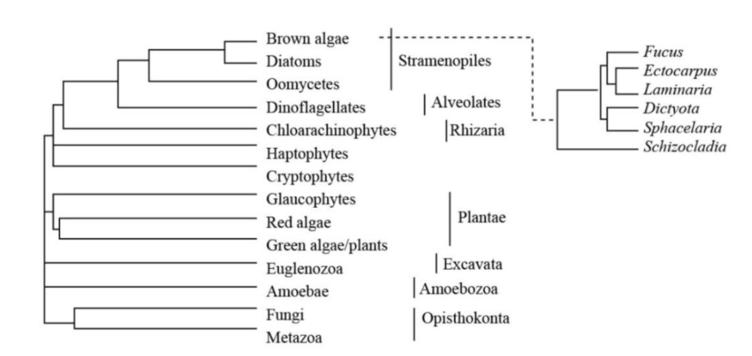
Concept explainers
To determine: The evolutionary significance of a choanoflagellate.
Introduction: Chloroplasts are the organelles that are necessary for photosynthesis. They are found exclusively in plant cells and some cells of algae. They contain the pigment chlorophyll that is used for driving the process as it contains various proteins that convert carbon dioxide into carbohydrate molecules.
Explanation of Solution
Pictorial representation: The figure represents the phylogenetic relationship between red, green, and brown algae.

Fig.1: The phylogenetic relationship between red, green and brown algae
The autotrophs are the organisms that can synthesize their food by the process of photosynthesis. They harvest the energy from sunlight and convert it into usable form carbohydrate cause glucose. The autotrophs include plants, some bacteria, and algae. The algae are of three types depending upon the pigment present in their chloroplast. These three groups are Phaeophyceae, Rhodophyceae, and Chlorophyceae. The green algae Chlorophyceae is known to give rise to land plants that are modern-day photosynthetic organisms.
Want to see more full solutions like this?
Chapter 28 Solutions
1 SEM CARDLESS ACC W/RAVEN TEXT
- 4). Imagine there are 2 alleles at a locus (A and a). a). If p = 0.75, what is q? b). Given p of 0.75, what is p²? c). For a sample of 200 individuals and if p = 0.75, how many individuals would we expect to carry the genotype AA? d). For a sample of 200 individuals, if p = 0.75, how many individuals would we expect to carry the genotype Aa? e) For a sample of 200 individuals, if p = 0.75, how many individuals would we expect to carry the genotype aa?arrow_forwardOur body-water-compartments can be separated into three distinct andfundamental regions. Which of the three is the largest?a. Plasmab. Interstitial fluidc. Intracellulard. All of the above are the same volume; and must always stay the samearrow_forwardOur body-water-compartments can be separated into three distinct andfundamental regions. Which of the three is the largest?a. Plasmab. Interstitial fluidc. Intracellulard. All of the above are the same volume; and must always stay the samearrow_forward
- Proteins serve as the “machinery” for the living cells. What type of moleculesserve as blueprints and allow a cell to correctly produce its’ proteins?A. CarbohydratesB. GenesC. GametesD. Lipidsarrow_forwardWhich of the following molecules will not dissolve in water?a. Non-polar Lipophilic moleculesb. Glucosec. Polar Hydrophilic moleculesd. Electrolytese. None of the above is correctarrow_forwardPhospholipids:A. are proteins.B. are amphipathic.C. are amino acid polymers.D. are monosaccharidesarrow_forward
- Enzymes are:A. proteinsB. nucleic acid polymersC. lipidsD. phospholipid polymersarrow_forwardWhich of the following molecules possess both polar (hydrophilic) & non-polar(hydrophobic) regions?A. triglyceridesB. carbohydratesC. phospholipids.D. Both A and B are correctarrow_forwardThe functional structure of a protein is its' _________________ structure,which is ultimately determined by the __________________.A. tertiary; primary structure.B. primary; ions it possesses.C. tertiary; concentration of phosphates.D. monogamous; first amino acid on the terminal sequencearrow_forward
- The sub-atomic particles which possess a positive charge are the:A. protonsB. neutronsC. electronsD. croutonsarrow_forwardThe ability or capacity to “store” Energy, from the Sun, is limited to a certaintype of molecule found on the planet. Which of the following characteristicsallow molecules to harness and store “sunlight” energy?A. molecules like electrolytes because they have charge.B. molecules like water because they are everywhere.C. molecules with Carbon – Carbon & Carbon – Hydrogen Bonds.D. molecules found only in the gaseous form.arrow_forwardAn ionic reaction leads to formation of:A. cations and anions.B. amino acids and fatty acids.C. glycogen from glucose.D. carbohydratesarrow_forward
 Biology: The Dynamic Science (MindTap Course List)BiologyISBN:9781305389892Author:Peter J. Russell, Paul E. Hertz, Beverly McMillanPublisher:Cengage Learning
Biology: The Dynamic Science (MindTap Course List)BiologyISBN:9781305389892Author:Peter J. Russell, Paul E. Hertz, Beverly McMillanPublisher:Cengage Learning Biology (MindTap Course List)BiologyISBN:9781337392938Author:Eldra Solomon, Charles Martin, Diana W. Martin, Linda R. BergPublisher:Cengage Learning
Biology (MindTap Course List)BiologyISBN:9781337392938Author:Eldra Solomon, Charles Martin, Diana W. Martin, Linda R. BergPublisher:Cengage Learning Biology 2eBiologyISBN:9781947172517Author:Matthew Douglas, Jung Choi, Mary Ann ClarkPublisher:OpenStax
Biology 2eBiologyISBN:9781947172517Author:Matthew Douglas, Jung Choi, Mary Ann ClarkPublisher:OpenStax


